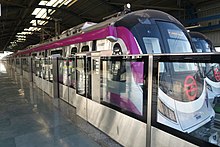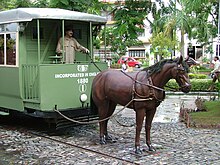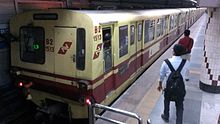Urban rail transport in India



Urban rail transport is a type of rail transport in India which has trains run in a city or urban area. There are four types of urban rail transport systems in India, for example rapid transit (metro), commuter rail (suburban rail), monorail and tram.
From a report of 2021, 2.63 billion people use metro systems of India every year. Sixteen large cities in India use metro systems. The report places the country as one of the busiest rapid transit systems in the world if we take the number of passengers using the system. The metro systems in India are 905 kilometres (562 miles) long and it is the third longest active metro system in the world.[1]
The Ministry of Housing and Urban Affairs is a ministry of the Government of India. Its Urban Transport wing works on the stuff about urban transport systems. This includes metro rail programmes. The ministry follows the provisions of the National Urban Transport Policy, 2006.[2]
The Delhi–Meerut Regional Rapid Transit System is the fastest urban rail transport system in India. It can run as fast as 180 kilometres per hour (110 miles per hour). The Meerut Metro is the fastest metro system in India. It can run as fast as 120 kilometres per hour (75 miles per hour).[3]
History[change | change source]
Early history[change | change source]

Commuter rail or suburban rail is the first type of urban rail transport system. It was first built in Mumbai on 16 April 1853. Its first passenger train ran from Bori Bunder (now Chhatrapati Shivaji Maharaj Terminus) to Thane. The distance between the two rail stations is 34 kilometres (21 miles). The passenger train ran over the distance in an hour and 15 minutes. This is Asia's first commuter rail system.[4]
Four large cities in India stated tram systems at the end of the 20th century, for example Chennai, Delhi, Kolkata and Mumbai. The trams helped people travel in large cities. Kolkata started its tram system in 1873 and the trams were pulled by horses. Chennai started its tram system in 1895 and the trams were run by electricity. After that, Mumbai, Kanpur and Delhi started their tram systems. Most cities stopped running trams between 1933 and 1964, but Kolkata never stopped running trams. Kolkata is the only city in India that still runs trams. The trams of Kolkata run on streets as heritage.[5]
Metro[change | change source]

Walter Ewing Crum set up a committee in September 1919 when a session of the Imperial Legislative Council in Shimla was running. The committee gave an advice to build a metro rail line for Kolkata.[6] The Government of West Bengal planned a metro system in 1949–1950 and French experts did a survey. But no one built a metro rail in India till 1972. The authority laid the foundation stone of India's first metro system in Kolkata in 1972. The system became active on 24 October 1984. The Kolkata Metro was 3.4 kilometres (2.1 miles) long with five stations.[7]
A study on traffic and travel characteristics of Delhi was done in 1969. Many people put up plans on building a metro system in Delhi at the time.[8] Buses were the main type of public transport in Delhi but they quickly ran out of capacity. The traffic of Delhi was also going up. People considered the ideas of an urban transport system as the need for the city.[8] The authority made a plan in 1984. Three corridors under the ground and changes in the suburban rail system were parts of the plan. The authority started building the Delhi Metro on 1 October 1998. Its first metro line became active on 24 December 2002.[7][9] As of 2021, the total length of the Delhi Metro is 348.12 kilometres (216.31 miles). It is the longest and the busiest metro system in India. Other Indian cities think of the Delhi Metro as a role model.[10]
Chennai Mass Rapid Transit System became active on 1 November 1995. It is the first elevated railway line in India. It is also the longest elevated rail line of the country. Its length is 17 kilometres (11 miles).[11][12]
Monorail[change | change source]
The political capital of India is in Delhi. The city had a success for making new metro lines. Mumbai is the country's financial capital. Suburban rail was the main type of transport in the city. The Mumbai Metropolitan Region Development Authority (MMRDA) said that the bus services in Mumbai ran through the city's narrow and crowded areas (areas with many people). The buses moved slowly and jammed in traffic. This is why the authority thought an urban transport system was needed. Mumbai had a plan of a metro system. The suburban rail connected main parts of the city. So the authority made up a plan to build a monorail in Mumbai.[13] The Mumbai Monorail was opened on 2 February 2014. It is India's first monorail system.[14][15]
Many large cities in India made up plans to build a monorail as a solution to the urban transport. But the Mumbai Monorail had shown its own problems quickly,[16] for example low number of passengers, low efficiency to keep the tracks good and train slowing down at the switches. The monorail tracks were elevated (built above the ground). They had their own set of trains and depot (place where trains are kept). Many people were talking about the cost of making and running monorails. Almost all monorails around the world are used in amusement parks and similar theme parks. They were not used much as a solution to the urban transport.[17] People thought that a light rail system had more efficiency, lower cost and larger capacity than a monorail. This is why many Indian cities made plans of a metro rail or a light rail system in place of a monorail.[18]
Metro[change | change source]


Notes[change | change source]
Sources[change | change source]
- ↑ "One crore passengers riding metro systems per day in India: Hardeep Singh Puri". The Times of India. 27 October 2023. ISSN 0971-8257. Retrieved 3 November 2023.
- ↑ "Urban Transport". Ministry of Housing and Urban Affairs.
- ↑ "PM Modi Launches Delhi-Meerut RRTS Corridor: How is RAPIDX Different from Metro & Its Unique Features". News18. 20 October 2023. Retrieved 18 February 2024.
- ↑ "The History of Mumbai's Local Trains in 1 Minute". The Culture Tip. 13 September 2016.
- ↑ Smith, R.V. (17 February 2013). "When trams plied". The Hindu.
- ↑ "Kolkata's Tube Railway plan nipped in bud a century ago". The Times of India. 5 February 2020.
- ↑ 7.0 7.1 "History of Metro rail in India: Trams to driverless metro". Urban Transport News. 21 May 2021.
- ↑ 8.0 8.1 Siemiatycki, Matti (June 2006). "Message in a Metro: Building Urban Rail Infrastructure and Image in Delhi, India". International Journal of Urban and Regional Research. 30 (2): 277–292. doi:10.1111/j.1468-2427.2006.00664.x.
- ↑ "History of Delhi Metro". DMRC. Archived from the original on 25 September 2010. Retrieved 17 September 2009.
- ↑ "Delhi metro map". delhimetrorail.com. Retrieved 13 November 2021.
- ↑ Year Book 2009. Bright Publications. p. 569.
- ↑ "Country's first elevated railway track gets operational at Rohtak". Tribuneindia News Service. Retrieved 6 July 2021.
- ↑ "Mumbai monorail to run in two years". The Times of India. 27 September 2007. Retrieved 19 March 2009.
- ↑ "First mono runs crowded like the good old local". Mumbai Mirror. 1 February 2014. Retrieved 2 February 2014.
- ↑ Ateeq Shaikh (1 February 2014). "India's first monorail flagged off by Maharashtra's Chief Minister Prithviraj Chavan". DNA. Retrieved 2 February 2014.
- ↑ "Mumbai: Despite govt taking over operations, Monorail continues to be plagued with problems". The Times of India. 22 August 2021.
- ↑ "Why cities rarely build monorails, explained". Greater Greater Washington. 1 May 2018.
- ↑ "Failure of Mumbai's Monorail Holds Lessons for Urban Planners Everywhere". The Wire. 10 January 2019.
